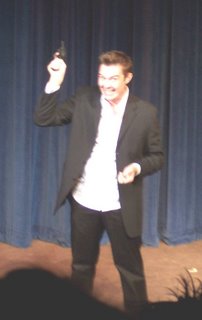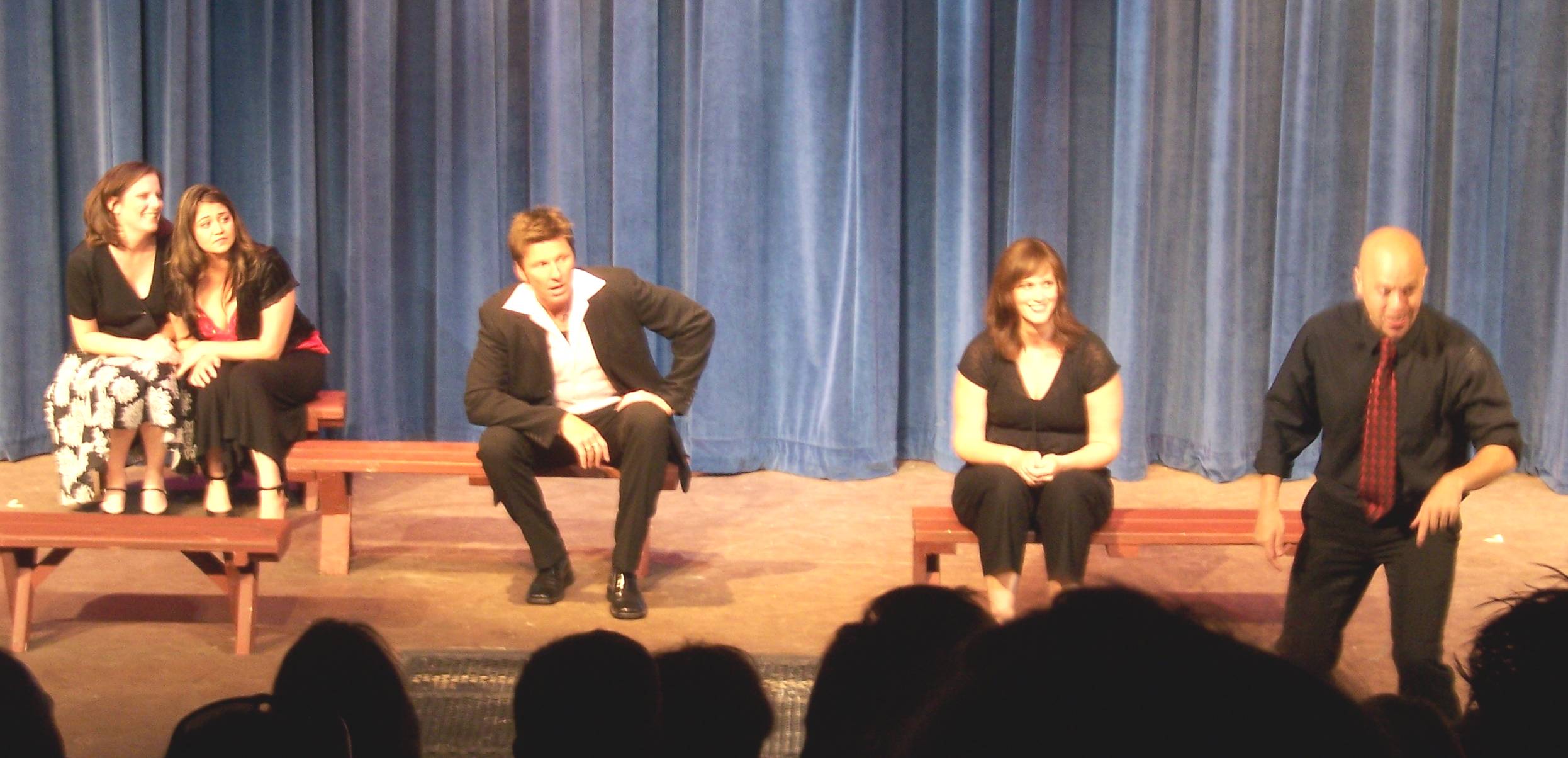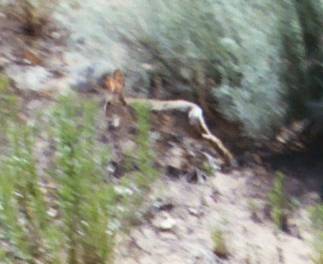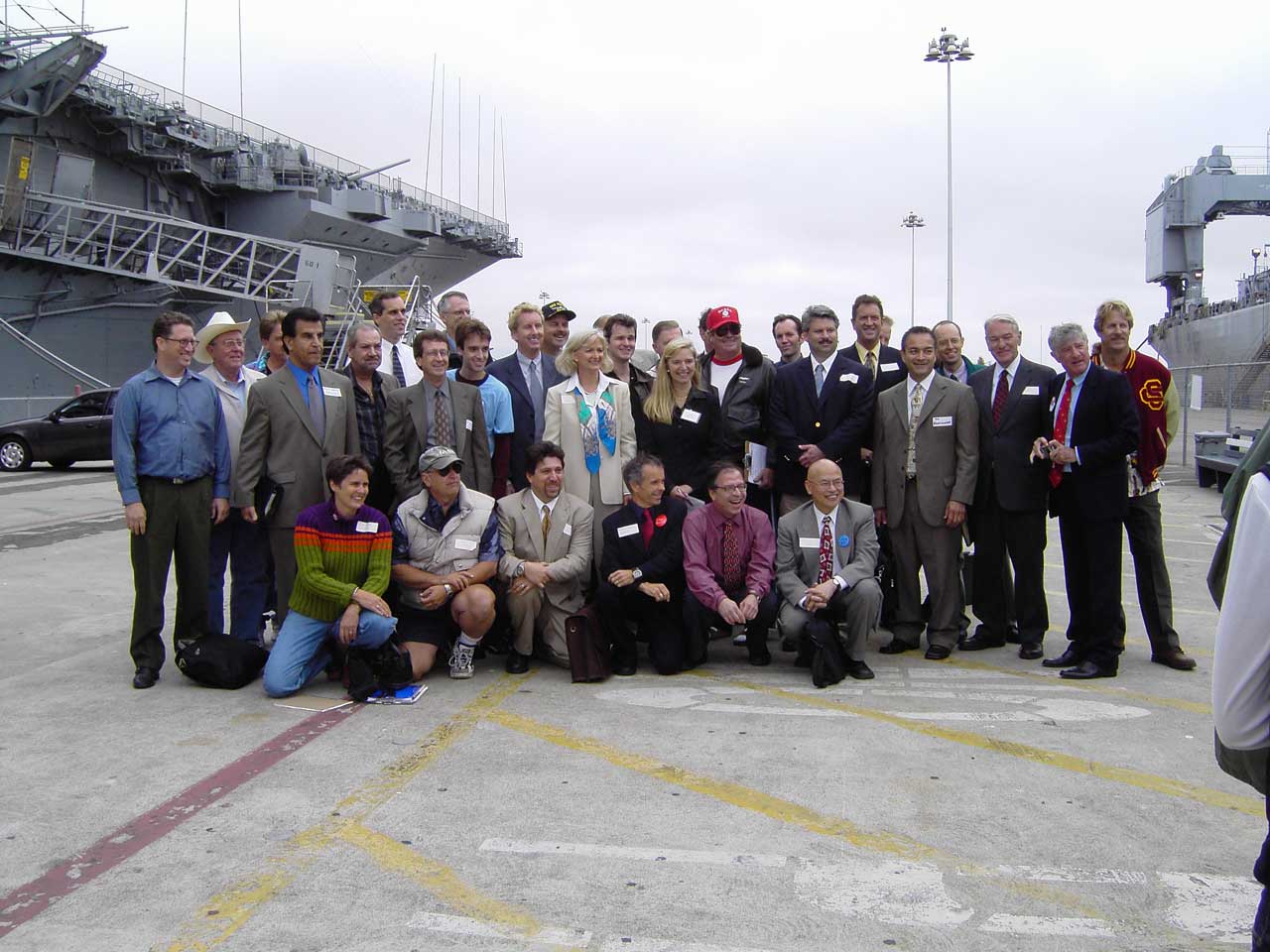Friday, July 07, 2006
Georgia O'Chipotle Dip Mix
See, E-Mail spam does have some use! Learn about unsuspected weird 'Arty' food (I wonder what gourmand and art-sensitive computer programmer James Bucanek would say?)
Link
See, E-Mail spam does have some use! Learn about unsuspected weird 'Arty' food (I wonder what gourmand and art-sensitive computer programmer James Bucanek would say?)
Link
Fever
My main advising professor at the University of Arizona was George Dawson, a fellow Englishman and friend to independent scientist James Lovelock. I remember when Lynn Margulis, one of Lovelock's colleagues, came to speak to us students at U of A.
Lovelock built very sensitive gas chromatographs. I especially liked the idea that if you had to obtain the very best gas chromatographs in the world, the very, very latest and most sensitive technology available anywhere, even if you were NASA or the CIA or MI5, you had to hunt Lovelock down in his little cottage in the remote English countryside, where he built these gizmos. The Gaia hypothesis is very much a valid scientific concept, which is one reason why the New Agers found it so attractive - it has a ring of truth to it, and is immensely appealing at all levels.
Regarding cockroaches (having done many experiments in southern Arizona, where they are as common as - cockroaches) I've discovered they will drown in a mild soap solution. Nevertheless, cockroaches resist being drawn into mild soap solutions, even when tempted with food, which is why these crafty devils will probably outlive us.
Here is James' essay:
---------------------------------
Marc,
I appreciate your review of "An Inconvenient Truth". I have not yet seen it but have heard much about it. Your analysis of the reasons for the reaction to global warming are well thought out and valid. Some who should know better still talk about evolution of the species, but species evolve as the result of individual decisions about where to live, how to acquire food, who to procreate with, and how to respond to intra-species competition and externally applied stressors. Even if we allow for the evolution of a cooperative strategy for survival, the cooperation of each group member rarely extends beyond the 100 or so other individuals that the typical individual can recognize as "my group". The prognosis for any cooperative effort to halt or slow global warming is not good, given the vast variation in economic status and political distrust of individuals all over the world.
There has never been much justification for the widely held view that homo sapiens is the pinacle of evolution and will inevitably continue to develop forever. I have never bought into the theory that evolution of human intelligence is a "good thing". It basically allows members of the species to sidestep evolved instinct and develop cultural evolution in parallel to biological evolution. This allows some individuals to analyse systems and to develop responses outside of past actions. Thus, better methods of hunting, agriculture, physical science, education, etc. lead to ever larger populations in response to overcrowding. In the bad old days overcrowing resulted in fewer survivors, forcing a return to a stable population level. In the last 100,000 or so years (a mere blink of an eye in the history of the Earth) we have developed an unstable forcing function that is driving the species toward an inevitable collapse. The effect on the species has been the development of autocratic political systems, very unequal economic systems, war, pestilence, and exponential deterioration of the environment. In a post-human world of mulicellular organisms, my money is on the cockroach. That is a species that is probably the epitome of biological evolution. It can take anything you can throw at it (with the possible exception of a well aimed shoe) and evolves fast enough to respond to changing environmental conditions.
As an atmospheric scientist, I assume you are familiar with the Gaia Hypothesis formulated by James Lovelock back in the '60s and published in the late '70s. Unfortunately it was glommed onto by many New Age proponents and has been given a bad reputation. I hold no brief that the Earth is some super-organism. In it's original form it was simply the recognition that in a closed system the sum total of the effects of biological evolution can affect the environment and apply a feedback to the direction of evolution. Eliminate the New Age garbage and think of the Earth as an (almost) closed system, and some interesting thought processes come bubbling up to the surface.
In an aside, Lovelock developed the hypothesis in response to a task assigned by NASA to develop methods to detect life on Mars by various probes and/or visits to the Mars surface. Lovelock was intelligent enough to realize that going all the way there, picking up a single (or very small number of) samples, then bringing them back for analyisis was not a good approach. Instead he suggested carefully analysing the Martian atmosphere by telescopic and low orbital probes to look for the by-products of a biological existance. This was not what NASA wanted to hear and he was quickly marginalized and berated as a pseudo-scientist. A scientist working for the Government ignores politics at his peril.
Think for the moment about the human body. Aside from the huge number of body cells that are the result of development from the original genome, there are an equivalent large number of bacteria, viruses, and single cell organisms inhabiting that universe. Some are essential to the function of the body, some are useful, some are benign fellow-travelers, and some are toxic organsims fully capable of making the body incapable of continuing life. Most of the time the bad ones are not numerous enough to outstrip the body's evolved defenses. Occasionally however, something will upset that equilibrium and the bad guys will start to muliply at a high rate and the body must seek to control the population. Please remember that the body does not think, "the Streptococci are getting uppity, I must nuke them back to the stone age". Instead, the presence of abnormal numbers of the errant biological organism is detected by the immune system, and a programmed (by evolution) response is initiated. Most of the time this is sufficient, but bacteria evolve also and sometimes they evade the defenses and a state of sepsis is achieved.
I find it very interesting that one of the regular defenses of the body in fighting off an infection is to raise body temperature, in some severe cases high enough to affect the bodys own cells adversely. Think now about the Earth as a closed system inhabited by numerous biological organisms, from the very same bacteria we have been considering, up(?) to homo sapiens. One of the organisms has begun to proliferate at an unstainable rate and producing effluent at rates that cannot be handled by the offsetting sinks that have evolved over time. One of many results is the concentration of heat trapping gasses in the atmosphere (obvious evidence of life, for any kibbitzing ET in the neighborhood). The organism is rapidly approaching a state of sepsis, and the Earth, acting as a closed system, is modifying the environment in a way to supress the organism. Thought provoking? Please remember that the Earth is not consciously acting to eliminate the threat, but is simply following the natural laws of Physics, as we all must, eventually.
There is another point here, we considered both the Earth and the human body as closed systems. Actually the human body is much less of a closed system than the Earth, thus the possiblilty of carrying infection from one body to another, and epidemics. If interstellar space travel ever actually occurs the possibility of interstellar epidemics becomes a likelihood. The question then becomes what side do we take? The side of the body hosting the infectious organism, or the side of the organism seeking a new host after destroying the old one? The Earth has huge restorative powers and once the infectious organism is gone it will most likely become even more lovely than before, just that no human will be there to destroy it. The cockroaches will no doubt sigh in relief. Actually, complete destruction of humanity is not neccessary, just a severe reduction in numbers, and perhaps a devolution of the human brain, much as whales lost their redundant legs upon returning to the sea.
The argument that the Earth is simply too massive and inert to be affected by a single species is not terribly convincing. The Earth's climate is a highly nonlinear system that can change abruptly over a geological instant. Human timescales are irrelavent. Non-linear control systems frequently have "trip-points" that can flip the system from one stable state to another very different stable state with little effort. Look at how many times and how quickly the Earth's magnetic field has inverted over geological time. The original inhabitants, bacteria and other archaic creatures, survived quite well in a reducing atmosphere, but still evolved into oxygen producing species, poisoning their own ancestors while preparing the way for more "efficient" oxygen cycle creatures. The point is, the Earth will survive, and perhaps prosper, but the inhabitants are more fragile.
Is this a pessimistic prediction of the future? Consider carefully. Think of a Earth with no Musical Theater, but also no Fox News and Reality TV. Nothing but green grass and blue sky, with flowering plants and fruitful trees, all organisms in balance with each other. Isn't that what we want? In the words of the imimitable Walt Kelly, "We have met the Enemy, and they are us!".
Jim McElroy
Link
Fever! In the morning,James McElroy has written an interesting essay, especially the part about Earth's 'fever!'
And fever all through the night
Everybody's got the fever
That is something you all know
Fever isn't such a new thing
Fever started long ago
My main advising professor at the University of Arizona was George Dawson, a fellow Englishman and friend to independent scientist James Lovelock. I remember when Lynn Margulis, one of Lovelock's colleagues, came to speak to us students at U of A.
Lovelock built very sensitive gas chromatographs. I especially liked the idea that if you had to obtain the very best gas chromatographs in the world, the very, very latest and most sensitive technology available anywhere, even if you were NASA or the CIA or MI5, you had to hunt Lovelock down in his little cottage in the remote English countryside, where he built these gizmos. The Gaia hypothesis is very much a valid scientific concept, which is one reason why the New Agers found it so attractive - it has a ring of truth to it, and is immensely appealing at all levels.
Regarding cockroaches (having done many experiments in southern Arizona, where they are as common as - cockroaches) I've discovered they will drown in a mild soap solution. Nevertheless, cockroaches resist being drawn into mild soap solutions, even when tempted with food, which is why these crafty devils will probably outlive us.
Here is James' essay:
---------------------------------
Marc,
I appreciate your review of "An Inconvenient Truth". I have not yet seen it but have heard much about it. Your analysis of the reasons for the reaction to global warming are well thought out and valid. Some who should know better still talk about evolution of the species, but species evolve as the result of individual decisions about where to live, how to acquire food, who to procreate with, and how to respond to intra-species competition and externally applied stressors. Even if we allow for the evolution of a cooperative strategy for survival, the cooperation of each group member rarely extends beyond the 100 or so other individuals that the typical individual can recognize as "my group". The prognosis for any cooperative effort to halt or slow global warming is not good, given the vast variation in economic status and political distrust of individuals all over the world.
There has never been much justification for the widely held view that homo sapiens is the pinacle of evolution and will inevitably continue to develop forever. I have never bought into the theory that evolution of human intelligence is a "good thing". It basically allows members of the species to sidestep evolved instinct and develop cultural evolution in parallel to biological evolution. This allows some individuals to analyse systems and to develop responses outside of past actions. Thus, better methods of hunting, agriculture, physical science, education, etc. lead to ever larger populations in response to overcrowding. In the bad old days overcrowing resulted in fewer survivors, forcing a return to a stable population level. In the last 100,000 or so years (a mere blink of an eye in the history of the Earth) we have developed an unstable forcing function that is driving the species toward an inevitable collapse. The effect on the species has been the development of autocratic political systems, very unequal economic systems, war, pestilence, and exponential deterioration of the environment. In a post-human world of mulicellular organisms, my money is on the cockroach. That is a species that is probably the epitome of biological evolution. It can take anything you can throw at it (with the possible exception of a well aimed shoe) and evolves fast enough to respond to changing environmental conditions.
As an atmospheric scientist, I assume you are familiar with the Gaia Hypothesis formulated by James Lovelock back in the '60s and published in the late '70s. Unfortunately it was glommed onto by many New Age proponents and has been given a bad reputation. I hold no brief that the Earth is some super-organism. In it's original form it was simply the recognition that in a closed system the sum total of the effects of biological evolution can affect the environment and apply a feedback to the direction of evolution. Eliminate the New Age garbage and think of the Earth as an (almost) closed system, and some interesting thought processes come bubbling up to the surface.
In an aside, Lovelock developed the hypothesis in response to a task assigned by NASA to develop methods to detect life on Mars by various probes and/or visits to the Mars surface. Lovelock was intelligent enough to realize that going all the way there, picking up a single (or very small number of) samples, then bringing them back for analyisis was not a good approach. Instead he suggested carefully analysing the Martian atmosphere by telescopic and low orbital probes to look for the by-products of a biological existance. This was not what NASA wanted to hear and he was quickly marginalized and berated as a pseudo-scientist. A scientist working for the Government ignores politics at his peril.
Think for the moment about the human body. Aside from the huge number of body cells that are the result of development from the original genome, there are an equivalent large number of bacteria, viruses, and single cell organisms inhabiting that universe. Some are essential to the function of the body, some are useful, some are benign fellow-travelers, and some are toxic organsims fully capable of making the body incapable of continuing life. Most of the time the bad ones are not numerous enough to outstrip the body's evolved defenses. Occasionally however, something will upset that equilibrium and the bad guys will start to muliply at a high rate and the body must seek to control the population. Please remember that the body does not think, "the Streptococci are getting uppity, I must nuke them back to the stone age". Instead, the presence of abnormal numbers of the errant biological organism is detected by the immune system, and a programmed (by evolution) response is initiated. Most of the time this is sufficient, but bacteria evolve also and sometimes they evade the defenses and a state of sepsis is achieved.
I find it very interesting that one of the regular defenses of the body in fighting off an infection is to raise body temperature, in some severe cases high enough to affect the bodys own cells adversely. Think now about the Earth as a closed system inhabited by numerous biological organisms, from the very same bacteria we have been considering, up(?) to homo sapiens. One of the organisms has begun to proliferate at an unstainable rate and producing effluent at rates that cannot be handled by the offsetting sinks that have evolved over time. One of many results is the concentration of heat trapping gasses in the atmosphere (obvious evidence of life, for any kibbitzing ET in the neighborhood). The organism is rapidly approaching a state of sepsis, and the Earth, acting as a closed system, is modifying the environment in a way to supress the organism. Thought provoking? Please remember that the Earth is not consciously acting to eliminate the threat, but is simply following the natural laws of Physics, as we all must, eventually.
There is another point here, we considered both the Earth and the human body as closed systems. Actually the human body is much less of a closed system than the Earth, thus the possiblilty of carrying infection from one body to another, and epidemics. If interstellar space travel ever actually occurs the possibility of interstellar epidemics becomes a likelihood. The question then becomes what side do we take? The side of the body hosting the infectious organism, or the side of the organism seeking a new host after destroying the old one? The Earth has huge restorative powers and once the infectious organism is gone it will most likely become even more lovely than before, just that no human will be there to destroy it. The cockroaches will no doubt sigh in relief. Actually, complete destruction of humanity is not neccessary, just a severe reduction in numbers, and perhaps a devolution of the human brain, much as whales lost their redundant legs upon returning to the sea.
The argument that the Earth is simply too massive and inert to be affected by a single species is not terribly convincing. The Earth's climate is a highly nonlinear system that can change abruptly over a geological instant. Human timescales are irrelavent. Non-linear control systems frequently have "trip-points" that can flip the system from one stable state to another very different stable state with little effort. Look at how many times and how quickly the Earth's magnetic field has inverted over geological time. The original inhabitants, bacteria and other archaic creatures, survived quite well in a reducing atmosphere, but still evolved into oxygen producing species, poisoning their own ancestors while preparing the way for more "efficient" oxygen cycle creatures. The point is, the Earth will survive, and perhaps prosper, but the inhabitants are more fragile.
Is this a pessimistic prediction of the future? Consider carefully. Think of a Earth with no Musical Theater, but also no Fox News and Reality TV. Nothing but green grass and blue sky, with flowering plants and fruitful trees, all organisms in balance with each other. Isn't that what we want? In the words of the imimitable Walt Kelly, "We have met the Enemy, and they are us!".
Jim McElroy
Link
Singing Careers
It would be fun to have Lata Mangeshkar's career:
Link
It would be fun to have Lata Mangeshkar's career:
Having music by a famous composer like Rahman or the Kalyanji-Anandji duo, who were roughly his '70s equivalent, is as likely to make a movie a hit as having big stars, because of how much Indians love their movie music. Every movie has five or ten song-and-dance numbers scattered throughout its three hours, during which the stars lip-sync and dance, Busby Berkeley-style, to songs prerecorded by famous playback singers. The most well-known are Asha Bhosle, her sister Lata Mangeshkar, Mohammed Rafi and Kishore Kumar. Supposedly, Lata has sung in almost 20 languages for over 1,825 films, worked with 165 composers, and made 8,000 recordings overall, more than anyone else.
Link
Wednesday, July 05, 2006
"You're Not Seeing The Big Picture Here, Miss Lane!"

In 1978, "Superman" with Christopher Reeve was released. At the time, I was attending the University of New Mexico, and immediately, coeds all around me were swooning and fainting. "He is SO handsome!, etc., etc., etc., etc." For months, the hero worship swelled like a wave. For me, the experience was like listening to nails on a chalkboard, without interruption, for months. I hated it. So, I was not looking forward to seeing this movie, with Brandon Routh as the 'Man of Steel,' but I knew my grim duty.
To my surprise, I thought this new movie, "Superman Returns," was great (maybe because I count fewer coeds among my compatriots these days). The visual effects, which cost a whopping $261 million (according to the Wall Street Journal in a recent front page article), were done with a real loving care for landscapes and seascapes. These digital masters really care about what the Earth looks like from space, from the air, and from every other place. They are geeks - real geeks, true geeks - who like geophysics, and how the Earth actually works. Thank God Time-Warner resisted the impulse to go cheap on the visuals! The only fake -looking scenes are the crystal land- and sea-scapes, but there was no choice here - they have no natural analogue. The physics is "Comic-Book Physics" of course, but they could have done SO MUCH WORSE!
The near-futuresque scenes were heightened by rational extrapolation to a second-generation Space Shuttle,whose design was anticipated by futuristic designs as long ago as 1960. Nothing science-fictiony there really: it's all easily-reachable with current technology.
Brandon Routh looks a bit 'plasticky,' in both the promotional stills, and in the movie itself. Is that a good thing? I think so: it serves to maintain the not-quite-human mystique of 'Superman.'
Kevin Spacey makes a superb Lex Luthor: selfish, businesslike, and hardly even THAT evil (until near the end). Kate Bosworth is a fine Lois Lane. I really liked seeing Broadway veteran Frank Langella (indeed, the only Broadway play I've ever seen was 'Dracula' in 1978, with Langella in the lead role) playing 'Daily Planet' Editor ('Great Caesar's Ghost!') Perry White. Parker Posey as Luthor's femme-fatale sidekick was a bit too cardboard for such a good actress (I blame the script here, however, not Posey).
The big question is, of course, whether Routh has what it takes to make coeds of this generation swoon. That's not my department, of course, and I really wish he wouldn't, but fear that he probably will do exactly the same as Reeve did 27 years ago. I just don't want to hear about it....
So, great movie! Go see it! It's much, much better, all around, than the 1978 Superman movie. Take it from someone who remembers, all too well, what that one was all about....
Link

In 1978, "Superman" with Christopher Reeve was released. At the time, I was attending the University of New Mexico, and immediately, coeds all around me were swooning and fainting. "He is SO handsome!, etc., etc., etc., etc." For months, the hero worship swelled like a wave. For me, the experience was like listening to nails on a chalkboard, without interruption, for months. I hated it. So, I was not looking forward to seeing this movie, with Brandon Routh as the 'Man of Steel,' but I knew my grim duty.
To my surprise, I thought this new movie, "Superman Returns," was great (maybe because I count fewer coeds among my compatriots these days). The visual effects, which cost a whopping $261 million (according to the Wall Street Journal in a recent front page article), were done with a real loving care for landscapes and seascapes. These digital masters really care about what the Earth looks like from space, from the air, and from every other place. They are geeks - real geeks, true geeks - who like geophysics, and how the Earth actually works. Thank God Time-Warner resisted the impulse to go cheap on the visuals! The only fake -looking scenes are the crystal land- and sea-scapes, but there was no choice here - they have no natural analogue. The physics is "Comic-Book Physics" of course, but they could have done SO MUCH WORSE!
The near-futuresque scenes were heightened by rational extrapolation to a second-generation Space Shuttle,whose design was anticipated by futuristic designs as long ago as 1960. Nothing science-fictiony there really: it's all easily-reachable with current technology.
Brandon Routh looks a bit 'plasticky,' in both the promotional stills, and in the movie itself. Is that a good thing? I think so: it serves to maintain the not-quite-human mystique of 'Superman.'
Kevin Spacey makes a superb Lex Luthor: selfish, businesslike, and hardly even THAT evil (until near the end). Kate Bosworth is a fine Lois Lane. I really liked seeing Broadway veteran Frank Langella (indeed, the only Broadway play I've ever seen was 'Dracula' in 1978, with Langella in the lead role) playing 'Daily Planet' Editor ('Great Caesar's Ghost!') Perry White. Parker Posey as Luthor's femme-fatale sidekick was a bit too cardboard for such a good actress (I blame the script here, however, not Posey).
The big question is, of course, whether Routh has what it takes to make coeds of this generation swoon. That's not my department, of course, and I really wish he wouldn't, but fear that he probably will do exactly the same as Reeve did 27 years ago. I just don't want to hear about it....
So, great movie! Go see it! It's much, much better, all around, than the 1978 Superman movie. Take it from someone who remembers, all too well, what that one was all about....
Link
Don't Bite Your Nails, And Get Out Of The Rain
Bizarro article:
Link
Bizarro article:
Physicians removed 119 nails - many of them rusty - from a woman's stomach months after she apparently swallowed them, a doctor said.But that isn't the strangest thing about iron....iron rain may be falling in the atmospheres of brown dwarf stars:
The atmospheres contain primarily gases, including gaseous iron and silicate. At hotter temperatures—3,140 degrees Fahrenheit (2,000 degrees Kelvin)—typical of younger brown dwarfs, the iron remains in its gaseous phase. Over time as the glowing body cools, the iron condenses to form iron-rich clouds and droplets of liquid-iron rain.
...And when it rains it pours: Not only did Burgasser and his team find these metallic clouds, but they also spotted evidence of violent storms. Thermodynamics would predict that as brown dwarfs release heat, they would dim—similar to a cooling ember. But the astronomers found that the older, and cooler, brown dwarfs shined brighter than the warmer, younger ones.
"These brown dwarfs are much brighter than they should be, and the only way for that to happen is for the clouds to disappear very suddenly so you're left with a very hot brown dwarf, which emits a lot of light, but doesn't have the same clouds," Burgasser said.
The most plausible explanation is an off-the-charts hurricane pummeling through the area and clearing the clouds. If the clouds were to clear naturally as the object cooled, that could take roughly 1 billion years, leaving a chilly brown dwarf, Burgasser told SPACE.com. He expects these clearings must be 100 times as quick, a "lightning-fast" 10 million years.
But what causes the cloudy disturbance? With cooling, a brown dwarf's cloud layer sinks closer to its surface.
"As the clouds form deeper in the atmosphere they are more sensitive to the winds and convective motions in the atmosphere," said Mark Marley, a scientist at NASA's Ames Research Center.
"This dynamics or 'weather' probably leads to the destruction of the clouds," Marley said by email, adding that he and others are working on promising ideas to explain the cloud-clearing mechanism.
Link
Australian Women In IT Aren't Geeks
No, really, they aren't, (but the clunky language makes me wonder):
Link
No, really, they aren't, (but the clunky language makes me wonder):
IT Goddess Calendar - Fundamentally the key reason for producing this calendar is to raise awareness of females in IT via capturing media attention and therefore increased stories, print and digital media reaching target audiences we have failed to reach via traditional means. We plan to do this by smashing through the geek perception by displaying a wide variety (jobs, age, nationality, roles and body shapes) of real women in IT fields, and using the style of calendar as a mechanism to instantly capture interest and attention (and sales).
Link
Senator Ted Stevens (R - Alaska) On The Internet
Would someone please get this guy some staff?:
Link
Would someone please get this guy some staff?:
I just the other day got, an internet was sent by my staff at 10 o'clock in the morning on Friday and I just got it yesterday. Why? Because it got tangled up with all these things going on the internet commercially. […]
They want to deliver vast amounts of information over the internet. And again, the internet is not something you just dump something on. It's not a truck. It's a series of tubes.
Link
Monday, July 03, 2006
 "Heart and Music Make A Song" - The Company Preview Show for "Artistic Differences"
"Heart and Music Make A Song" - The Company Preview Show for "Artistic Differences"Left: Jerry Lee as Charles Giteau (assassin of President James A. Garfield, 1881), from Stephen Sondheim's 'Ballad of Guiteau,' from "Assassins."
(Pictures taken with Steve's new digital camera - I've misplaced my own)
Sunday evening, the new musical theater group, "Artistic Differences," presented a preview concert at DMTC's Hoblit Performing Arts Center, in Davis, to an audience of about eighty people, featuring many of the area's best perfomers (both onstage and in the audience). Afterwards, there was much networking in the lobby of the theater,
Later this month, and in early August, "Artistic Differences" will present performances of William Finn and James Lapine's musical, "Falsettos," at DMTC.
Artistic Differences" intends to present contemporary musical theater and, as yet, doesn't have a permanent home. The group is a collaborative effort of some of the best singers in the local musical theater community, and as such, may not necessarily require a permanent home, but rather a host, such as DMTC now serves.
On June 28th, DMTC had a board meeting, where we discussed "Falsettos," after the customary griping about the burdens of operating, with volunteers, a new 'brick-and-mortar' theater that also serves as the host for several smaller theatrical ventures, including "Artistic Differences."
Steve tried to keep the board meeting on-message, but things quickly derailed. Treating us to a fill-in-the-blank, morale-boosting opening, Steve ceremoniously stated, "For us sitting at this table, musical theater is a ????" "A hobby!!!!," I happily babbled. Repeatedly smacking his forehead with the palm of his hand as he sagged forward with exasperation, Steve muttered, "A business! A business!"
For me, a hobby, for Steve, a business, but for the folks in "Artistic Differences," musical theater is more of a calling. It takes a lot of hard work and dedication to get that good!
The Board wondered about the folks in "Artistic Differences." "Do you think they might be interested in cleaning toilets?," someone wondered. This was a silly question, of course: I know these folks, some of them well, and I'm sure they don't have the slightest interest in cleaning toilets (if only, because they are long-time veterans of the local musical theater community, they've cleaned more than their share of toilets in the past).
Nevertheless, the conversation highlighted the basic conundrum DMTC now finds itself in. We would like a cleaning service, to ease our burdens, but require income from staging or hosting shows, such as those provided by "Artistic Differences," to pay for the services. Most theater companies need artistic differences like a hole in the head, but we need as many as we can get.
Waiting in the lobby, I talked with several people. First I talked with Dianne and Meeka Craig, who were both wondering when, or if, DMTC would extend the runs of certain popular shows, such as "Oklahoma!" That is one of extending runs was becoming increasingly theoretical in nature, not only because facility-use conflicts with other theatrical events were becoming increasingly common as the calendar filled up, but also because of the difficulty of getting every single one of the players to commit to time beyond what they had already anticipated.
I also talked with James Chavez-Glica, and we reminisced together about childhood in northern California, until I remembered I was reminiscing about Aaron Clemens childhood (who grew up with James) and not my own childhood, in New Mexico.
I also talked with Kathy and Tony Davi, who conveyed news of their talented daughters. Melody recently had sinus surgery, to deal with persistent infections, and we wondered how that surgical work might affect/improve her singing. Then Kathy and Tony announced that the San Francisco premiere of the revival of "A Chorus Line," starring Mara Davi as Maggie, would be at the Curran Theater on July 23rd:
Revivals, Hamlisch said, have never held much interest for him. "Once you've seen Zero Mostel in 'Fiddler,' do you really want to see someone else?" But "Chorus Line," in multiple ways, is a special case. Hamlisch will fine- tune the orchestrations, using a synthesizer not available in 1975, for example, but not change a note. One thing he hopes to do this time around is erase the memory of "the very bad movie of this show" directed by Richard Attenborough in 1985.This is a major, major event we should all watch out for!
The "Artistic Differences" concert was great. Lots of fine performances by many of Sacramento's best! Here are some pictures from the concert itself. Because of the poor lighting, many pictures didn't come out very well: these are some of the best:
Pictures from 'Gun Song,' from "Assassins":

Michael R.J. Campbell, and Kristen Wagner.

Kristen Wagner, Michael R.J. Campbell, Ken Figeroid, and Jerry Lee.

Kevin Caravalho and Jerry Lee.

Kristen Wagner, Michael R.J. Campbell, Kevin Caravalho, Jerry Lee, and Ken Figeroid.
Pictures from 'Miracle of Judaism/Baseball Game,' from "Falsettos":

Joey Harris.

Kristen Wagner, Jessica Stein, Craig Howard, Margaret Hollinbeck, and Kevin Caravalho.
Picture from 'Heart and Music,' from "A New Brain":

Kevin Caravalho, Joey Harris, Kristen Wagner, Jerry Lee, Craig Howard, Michael R.J. Campbell, Margaret Hollinbeck, Melissa Rae Frago, and Ken Figeroid.
Heart and music
Heart and music get along (you gotta have heart and music)
You gotta have heart and music
You gotta have heart and music
Heart and music make a song
Link









